Femto- to Millisecond Time-Resolved Photodynamics of a Double-Functionalized Push–Pull Organic Linker: Potential Candidate for Optoelectronically Active MOFs
Abstract
1. Introduction
2. Results and Discussion
2.1. Steady-state UV-Vis Absorption and Emission Studies
2.2. Time-correlated Single Photon Counting Emission Studies
2.3. Femtosecond Time-resolved Transient Absorption Studies
2.4. Flash Photolysis Transient Absorption Studies
3. Experimental part
3.1. Materials
3.2. Synthesis of Dimethyl 4-amino-8-cyanonaphthalene-2,6-dicarboxylate (Me2CANADC)
3.3. Methods
3.3.1. Materials Characterization Techniques
3.3.2. Steady-state and Time-resolved Characterization Techniques
4. Conclusions
Supplementary Materials
Author Contributions
Funding
Conflicts of Interest
References
- Zhou, H.-C.; Long, J.R.; Yaghi, O.M. Introduction to Metal–Organic Frameworks. Chem. Rev. 2012, 112, 673–674. [Google Scholar] [CrossRef]
- Kirchon, A.; Feng, L.; Drake, H.F.; Joseph, E.A.; Zhou, H.-C. From fundamentals to applications: A toolbox for robust and multifunctional MOF materials. Chem. Soc. Rev. 2018, 47, 8611–8638. [Google Scholar] [CrossRef]
- Baumann, A.E.; Burns, D.A.; Liu, B.; Thoi, V.S. Metal-organic framework functionalization and design strategies for advanced electrochemical energy storage devices. Commun. Chem. 2019, 2, 86. [Google Scholar] [CrossRef]
- Wang, H.; Zhu, Q.-L.; Zou, R.; Xu, Q. Metal-Organic Frameworks for Energy Applications. Chem 2017, 2, 52–80. [Google Scholar] [CrossRef]
- Wang, B.; Xie, L.-H.; Wang, X.; Liu, X.-M.; Li, J.; Li, J.-R. Applications of metal–organic frameworks for green energy and environment: New advances in adsorptive gas separation, storage and removal. Green Energy Environ. 2018, 3, 191–228. [Google Scholar] [CrossRef]
- Parui, J.; Saranya, D.; Krupanidhi, S. Smart Materials for Energy Harvesting, Energy Storage, and Energy Efficient Solid-State Electronic Refrigeration. In Micro and Smart Devices and Systems; Springer: Delhi, India, 2014; pp. 303–315. [Google Scholar]
- Zhang, H.; Liu, X.; Wu, Y.; Guan, C.; Cheetham, A.K.; Wang, J. MOF-derived nanohybrids for electrocatalysis and energy storage: Current status and perspectives. Chem. Commun. 2018, 54, 5268–5288. [Google Scholar] [CrossRef]
- Jiang, J.; Furukawa, H.; Zhang, Y.-B.; Yaghi, O.M. High methane storage working capacity in metal–organic frameworks with acrylate links. J. Am. Chem. Soc. 2016, 138, 10244–10251. [Google Scholar] [CrossRef]
- Gygi, D.; Bloch, E.D.; Mason, J.A.; Hudson, M.R.; Gonzalez, M.I.; Siegelman, R.L.; Darwish, T.A.; Queen, W.L.; Brown, C.M.; Long, J.R. Hydrogen storage in the expanded pore metal–organic frameworks M2 (dobpdc)(M= Mg, Mn, Fe, Co, Ni, Zn). Chem. Mater. 2016, 28, 1128–1138. [Google Scholar] [CrossRef]
- Roy, I.; Gupta, M.N. Smart polymeric materials: Emerging biochemical applications. Chem. Biol. 2003, 10, 1161–1171. [Google Scholar] [CrossRef]
- Levi, D.S.; Kusnezov, N.; Carman, G.P. Smart materials applications for pediatric cardiovascular devices. Pediatr. Res. 2008, 63, 552. [Google Scholar] [CrossRef]
- Alvarez-Lorenzo, C.; González-Chomón, C.; Concheiro, A. Molecularly imprinted hydrogels for affinity-controlled and stimuli-responsive drug delivery. In Smart materials for drug delivery; Royal Society of Chemistry: London, UK, 2013; pp. 228–260. [Google Scholar]
- Hu, Z.; Deibert, B.J.; Li, J. Luminescent metal–organic frameworks for chemical sensing and explosive detection. Chem. Soc. Rev. 2014, 43, 5815–5840. [Google Scholar] [CrossRef]
- Lustig, W.P.; Mukherjee, S.; Rudd, N.D.; Desai, A.V.; Li, J.; Ghosh, S.K. Metal–organic frameworks: Functional luminescent and photonic materials for sensing applications. Chem. Soc. Rev. 2017, 46, 3242–3285. [Google Scholar] [CrossRef]
- Chaudhari, A.K.; Kim, H.J.; Han, I.; Tan, J.-C. Optochemically Responsive 2D Nanosheets of a 3D Metal–Organic Framework Material. Adv. Mater. 2017, 29, 1701463. [Google Scholar] [CrossRef] [PubMed]
- Gutiérrez, M.; Martin, C.; Kennes, K.; Hofkens, J.; Van der Auweraer, M.; Sánchez, F.; Douhal, A. New OLEDs Based on Zirconium Metal-Organic Framework. Adv. Opt. Mater. 2018, 6, 1701060. [Google Scholar] [CrossRef]
- Allendorf, M.; Bauer, C.; Bhakta, R.; Houk, R. Luminescent metal–organic frameworks. Chem. Soc. Rev. 2009, 38, 1330–1352. [Google Scholar] [CrossRef] [PubMed]
- Gutiérrez, M.; Sánchez, F.; Douhal, A. Spectral and dynamical properties of a Zr-based MOF. Phys. Chem. Chem. Phys. 2016, 18, 5112–5120. [Google Scholar] [CrossRef]
- Gutiérrez, M.; Sánchez, F.; Douhal, A. Competitive Excimer Formation and Energy Transfer in Zr-Based Heterolinker Metal–Organic Frameworks. Chem. A Eur. J. 2016, 22, 13072–13082. [Google Scholar] [CrossRef]
- Gutierrez, M.; Cohen, B.; Sánchez, F.; Douhal, A. Photochemistry of Zr-based MOFs: Ligand-to-cluster charge transfer, energy transfer and excimer formation, what else is there? Phys. Chem. Chem. Phys. 2016, 18, 27761–27774. [Google Scholar] [CrossRef]
- Di Nunzio, M.R.; Caballero-Mancebo, E.; Cohen, B.; Douhal, A. Photodynamical Behaviour of MOFs and Related Composites: Relevance to Emerging Photon-Based Science and Applications. J. Photochem. Photobiol. C Rev. 2020, in press. [Google Scholar]
- Mieno, H.; Kabe, R.; Allendorf, M.D.; Adachi, C. Thermally activated delayed fluorescence of a Zr-based metal–organic framework. Chem. Commun. 2018, 54, 631–634. [Google Scholar] [CrossRef]
- Wang, B.; Lv, X.-L.; Feng, D.; Xie, L.-H.; Zhang, J.; Li, M.; Xie, Y.; Li, J.-R.; Zhou, H.-C. Highly Stable Zr(IV)-Based Metal–Organic Frameworks for the Detection and Removal of Antibiotics and Organic Explosives in Water. J. Am. Chem. Soc. 2016, 138, 6204–6216. [Google Scholar] [CrossRef] [PubMed]
- Flaig, R.W.; Osborn Popp, T.M.; Fracaroli, A.M.; Kapustin, E.A.; Kalmutzki, M.J.; Altamimi, R.M.; Fathieh, F.; Reimer, J.A.; Yaghi, O.M. The Chemistry of CO2 Capture in an Amine-Functionalized Metal–Organic Framework under Dry and Humid Conditions. J. Am. Chem. Soc. 2017, 139, 12125–12128. [Google Scholar] [CrossRef] [PubMed]
- Kang, M.; Kang, D.W.; Hong, C.S. Post-synthetic diamine-functionalization of MOF-74 type frameworks for effective carbon dioxide separation. Dalton Trans. 2019, 48, 2263–2270. [Google Scholar] [CrossRef] [PubMed]
- Jeon, S.K.; Lee, H.L.; Yook, K.S.; Lee, J.Y. Recent Progress of the Lifetime of Organic Light-Emitting Diodes Based on Thermally Activated Delayed Fluorescent Material. Adv. Mater. 2019, 31, 1803524. [Google Scholar] [CrossRef]
- Godumala, M.; Choi, S.; Cho, M.J.; Choi, D.H. Recent breakthroughs in thermally activated delayed fluorescence organic light emitting diodes containing non-doped emitting layers. J. Mater. Chem. C 2019, 7, 2172–2198. [Google Scholar] [CrossRef]
- Dolgopolova, E.A.; Rice, A.M.; Martin, C.R.; Shustova, N.B. Photochemistry and photophysics of MOFs: Steps towards MOF-based sensing enhancements. Chem. Soc. Rev. 2018, 47, 4710–4728. [Google Scholar] [CrossRef]
- Gutiérrez, M.; Sánchez, F.; Douhal, A. Efficient multicolor and white light emission from Zr-based MOF composites: Spectral and dynamic properties. J. Mater. Chem. C 2015, 3, 11300–11310. [Google Scholar] [CrossRef]
- Deria, P.; Yu, J.; Smith, T.; Balaraman, R.P. Ground-State versus Excited-State Interchromophoric Interaction: Topology Dependent Excimer Contribution in Metal–Organic Framework Photophysics. J. Am. Chem. Soc. 2017, 139, 5973–5983. [Google Scholar] [CrossRef]
- Hou, Y.; Zhang, X.; Chen, K.; Liu, D.; Wang, Z.; Liu, Q.; Zhao, J.; Barbon, A. Charge separation, charge recombination, long-lived charge transfer state formation and intersystem crossing in organic electron donor/acceptor dyads. J. Mater. Chem. C 2019, 7, 12048–12074. [Google Scholar] [CrossRef]
- Ohkubo, K.; Fukuzumi, S. Long-lived charge-separated states of simple electron donor-acceptor dyads using porphyrins and phthalocyanines. J. Porphyr. Phthalocyanines 2008, 12, 993–1004. [Google Scholar] [CrossRef]
- Luzzati, S.; Scharber, M.; Catellani, M.; Giacalone, F.; Segura, J.L.; Martin, N.; Neugebauer, H.; Sariciftci, N.S. Long-Lived Photoinduced Charges in Donor−Acceptor Anthraquinone-Substituted Thiophene Copolymers. J. Phys. Chem. B 2006, 110, 5351–5358. [Google Scholar] [CrossRef]
- Mataga, N. Solvent Effects on the Absorption and Fluorescence Spectra of Naphthylamines and Isomeric Aminobenzoic Acids. Bull. Chem. Soc. Jpn. 1963, 36, 654–662. [Google Scholar] [CrossRef]
- Mac, M.; Baran, W.; Uchacz, T.; Baran, B.; Suder, M.; Leśniewski, S. Fluorescence properties of the derivatives of oxazolo [4,5-b]pyridyne. J. Photochem. Photobiol. A 2007, 192, 188–196. [Google Scholar] [CrossRef]
- Vázquez, M.E.; Blanco, J.B.; Imperiali, B. Photophysics and Biological Applications of the Environment-Sensitive Fluorophore 6-N,N-Dimethylamino-2,3-naphthalimide. J. Am. Chem. Soc. 2005, 127, 1300–1306. [Google Scholar] [CrossRef] [PubMed]
- Mishra, A.; Sahu, S.; Tripathi, S.; Krishnamoorthy, G. Photoinduced intramolecular charge transfer in trans-2-[4′-(N,N-dimethylamino)styryl]imidazo[4,5-b]pyridine: Effect of introducing a C=C double bond. Photochem. Photobiol. Sci. 2014, 13, 1476–1486. [Google Scholar] [CrossRef] [PubMed]
- Sumalekshmy, S.; Gopidas, K. Photoinduced intramolecular charge transfer in donor acceptor substituted tetrahydropyrenes. J. Phys. Chem. B 2004, 108, 3705–3712. [Google Scholar] [CrossRef]
- Caballero-Mancebo, E.; Cohen, B.; Smolders, S.; De Vos, D.E.; Douhal, A. Unravelling Why and to What Extent the Topology of Similar Ce-Based MOFs Conditions their Photodynamic: Relevance to Photocatalysis and Photonics. Adv. Sci. 2019, 6, 1901020. [Google Scholar] [CrossRef] [PubMed]
- Zachariasse, K.A.; Von Der Haar, T.; Hebecker, A.; Leinhos, U.; Kuhnle, W. Intramolecular charge transfer in aminobenzonitriles: Requirements for dual fluorescence. Pure Appl. Chem. 1993, 65, 1745–1750. [Google Scholar] [CrossRef]
- Coto, P.B.; Serrano-Andrés, L.; Gustavsson, T.; Fujiwara, T.; Lim, E.C. Intramolecular charge transfer and dual fluorescence of 4-(dimethylamino) benzonitrile: Ultrafast branching followed by a two-fold decay mechanism. Phys. Chem. Chem. Phys. 2011, 13, 15182–15188. [Google Scholar] [CrossRef]
- Banerji, N.; Angulo, G.; Barabanov, I.; Vauthey, E. Intramolecular Charge-Transfer Dynamics in Covalently Linked Perylene− Dimethylaniline and Cyanoperylene− Dimethylaniline. J. Phys. Chem. A 2008, 112, 9665–9674. [Google Scholar] [CrossRef][Green Version]
- Tomin, V.I.; Hubisz, K. Inhomogeneous spectral broadening and the decay kinetics of the luminescence spectra of prodan. Opt. Spectrosc. 2006, 101, 98–104. [Google Scholar] [CrossRef]
- Grabowski, Z.R.; Rotkiewicz, K.; Rettig, W. Structural Changes Accompanying Intramolecular Electron Transfer: Focus on Twisted Intramolecular Charge-Transfer States and Structures. Chem. Rev. 2003, 103, 3899–4032. [Google Scholar] [CrossRef] [PubMed]
- Rettig, W. Charge separation in excited states of decoupled systems—TICT compounds and implications regarding the development of new laser dyes and the primary process of vision and photosynthesis. Angew. Chem. Int. Ed. 1986, 25, 971–988. [Google Scholar] [CrossRef]
- Alarcos, N.; Gutierrez, M.; Liras, M.; Sánchez, F.; Douhal, A. An abnormally slow proton transfer reaction in a simple HBO derivative due to ultrafast intramolecular-charge transfer events. Phys. Chem. Chem. Phys. 2015, 17, 16257–16269. [Google Scholar] [CrossRef] [PubMed]
- Alarcos, N.; Gutiérrez, M.; Liras, M.; Sánchez, F.; Moreno, M.; Douhal, A. Direct observation of breaking of the intramolecular H-bond, and slowing down of the proton motion and tuning its mechanism in an HBO derivative. Phys. Chem. Chem. Phys. 2015, 17, 14569–14581. [Google Scholar] [CrossRef]
- Gutierrez, M.; Alarcos, N.; Liras, M.; Sánchez, F.; Douhal, A. Switching to a Reversible Proton Motion in a Charge-Transferred Dye. J. Phys. Chem. B 2015, 119, 552–562. [Google Scholar] [CrossRef][Green Version]
- Alarcos, N.; Gutiérrez, M.; Liras, M.; Sánchez, F.; Douhal, A. From intra- to inter-molecular hydrogen bonds with the surroundings: Steady-state and time-resolved behaviours. Photochem. Photobiol. Sci. 2015, 14, 1306–1318. [Google Scholar] [CrossRef][Green Version]
- Skaisgiris, R.; Serevičius, T.; Kazlauskas, K.; Geng, Y.; Adachi, C.; Juršėnas, S. Origin of dual emission in σ-bridged donor–acceptor TADF compounds. J. Mater. Chem. C 2019, 7, 12601–12609. [Google Scholar] [CrossRef]
- Ma, C.; Kwok, W.; Matousek, P.; Parker, A.; Phillips, D.; Toner, W.; Towrie, M. Resonance Raman study of ring deuterated 4-dimethylaminobenzonitrile (DMABN-d4): The ground, ICT and triplet states. J. Photochem. Photobiol. A: Chem. 2001, 142, 177–185. [Google Scholar] [CrossRef]
- Hashimoto, M.; Hamaguchi, H. Structure of the twisted-intramolecular-charge-transfer excited singlet and triplet states of 4-(dimethylamino) benzonitrile as studied by nanosecond time-resolved infrared spectroscopy. J. Phys. Chem. 1995, 99, 7875–7877. [Google Scholar] [CrossRef]
- Leresche, F.; Ludvíková, L.; Heger, D.; Klán, P.; von Gunten, U.; Canonica, S. Laser flash photolysis study of the photoinduced oxidation of 4-(dimethylamino)benzonitrile (DMABN). Photochem. Photobiol. Sci. 2019, 18, 534–545. [Google Scholar] [CrossRef] [PubMed]
- Demeter, A.; Zachariasse, K.A. Triplet state dipole moments of aminobenzonitriles. J. Phys. Chem. A 2008, 112, 1359–1362. [Google Scholar] [CrossRef]
- Fukuzumi, S.; Ohkubo, K.; Suenobu, T. Long-lived charge separation and applications in artificial photosynthesis. Acc. Chem. Res. 2014, 47, 1455–1464. [Google Scholar] [CrossRef] [PubMed]
- El-Khouly, M.E.; Chen, Y.; Zhuang, X.; Fukuzumi, S. Long-lived charge-separated configuration of a push—Pull archetype of disperse red 1 end-capped poly [9,9-bis (4-diphenylaminophenyl) fluorene]. J. Am. Chem. Soc. 2009, 131, 6370–6371. [Google Scholar] [CrossRef] [PubMed]
- Gutiérrez, M.; Navarro, R.; Sánchez, F.; Douhal, A. Photodynamics of Zr-based MOFs: Effect of explosive nitroaromatics. Phys. Chem. Chem. Phys. 2017, 19, 16337–16347. [Google Scholar] [CrossRef] [PubMed]
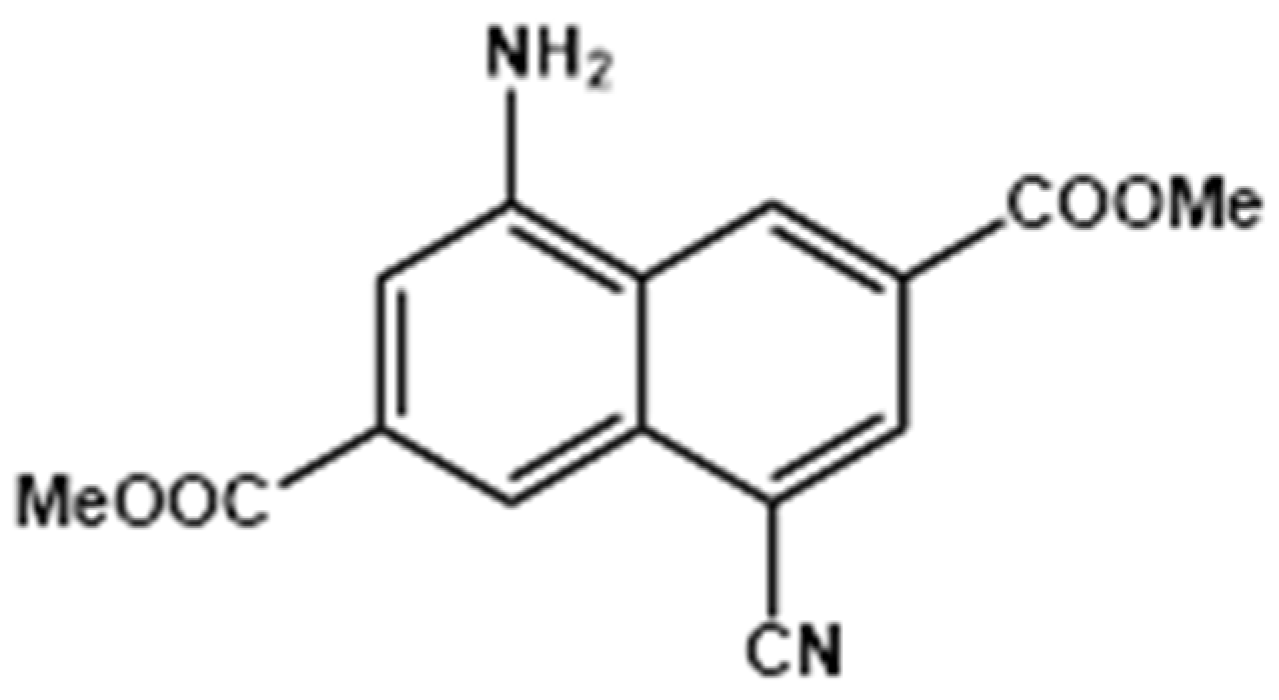
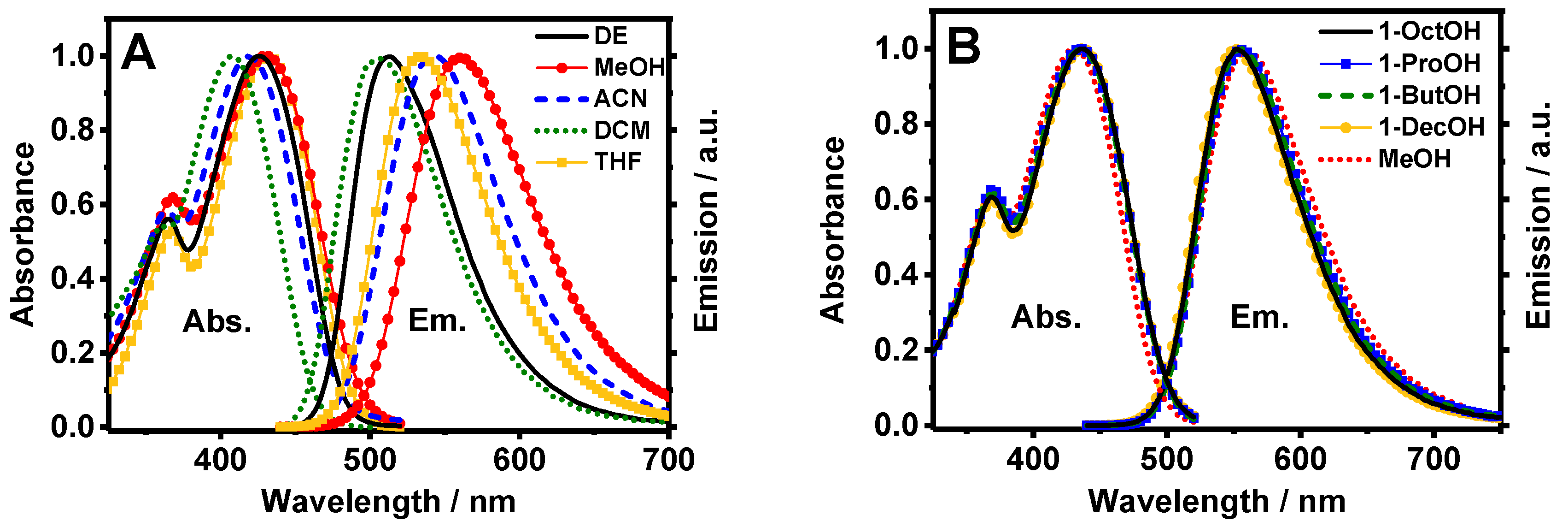
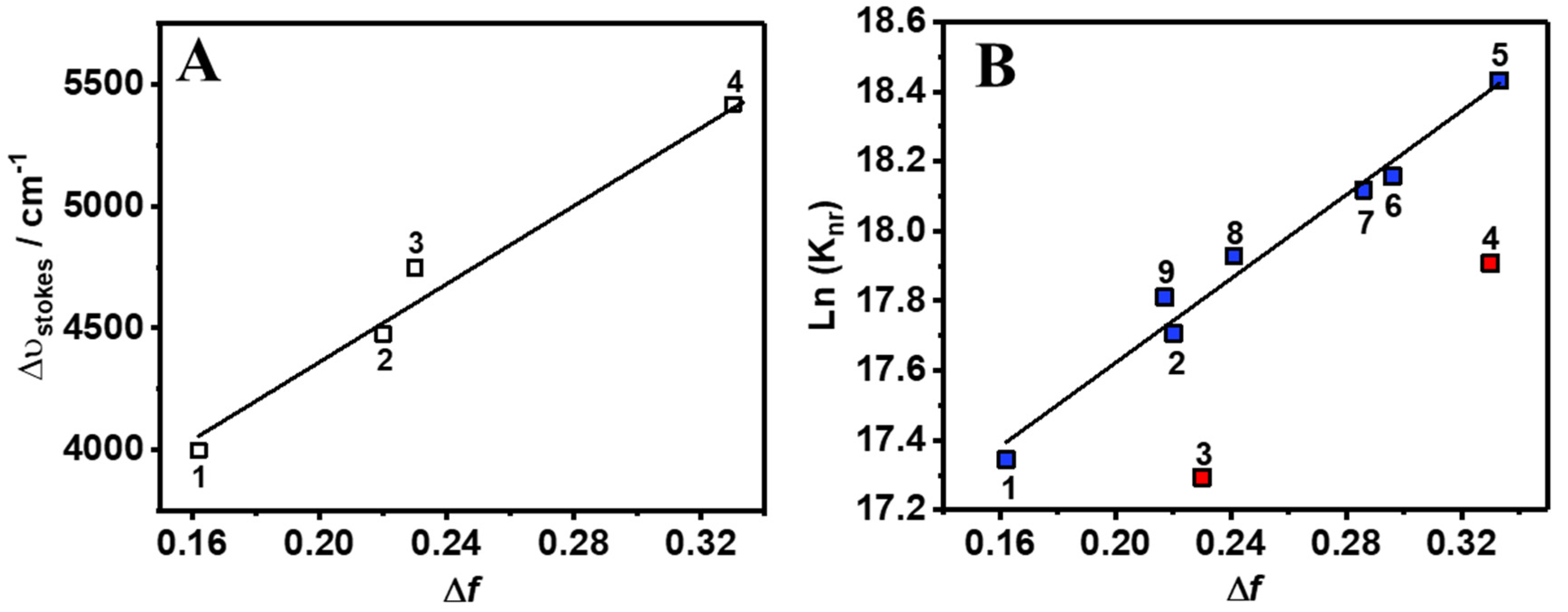
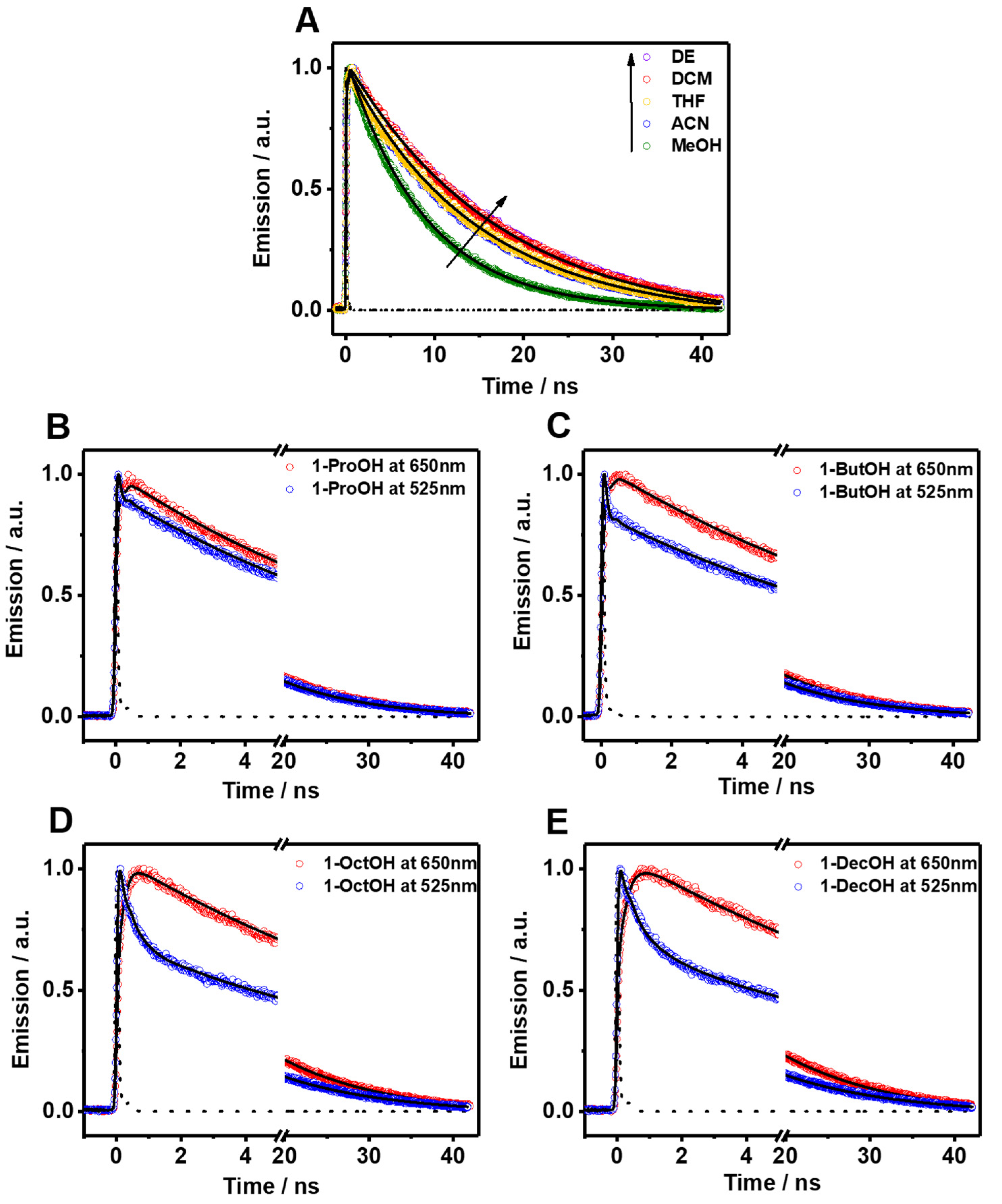
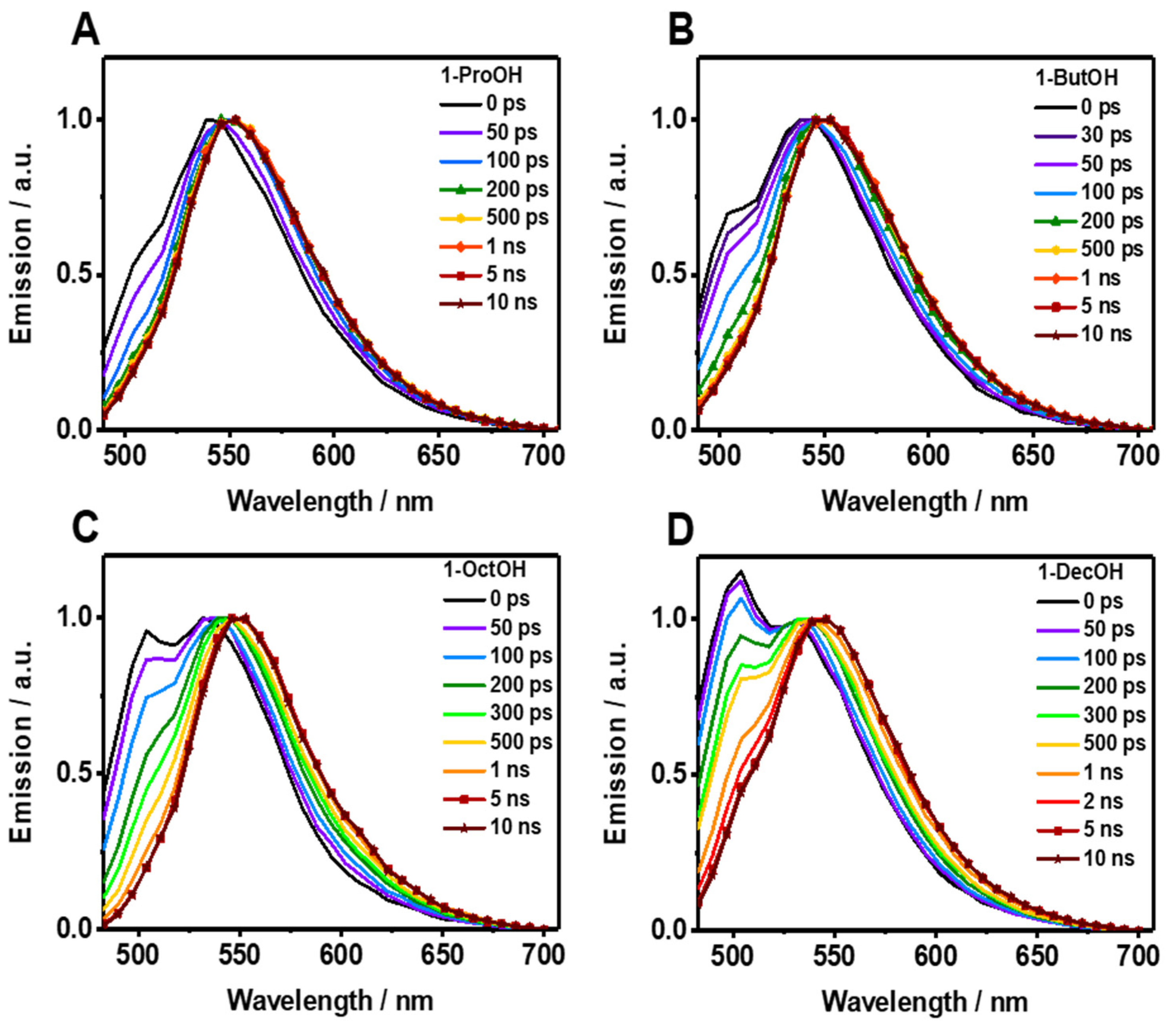
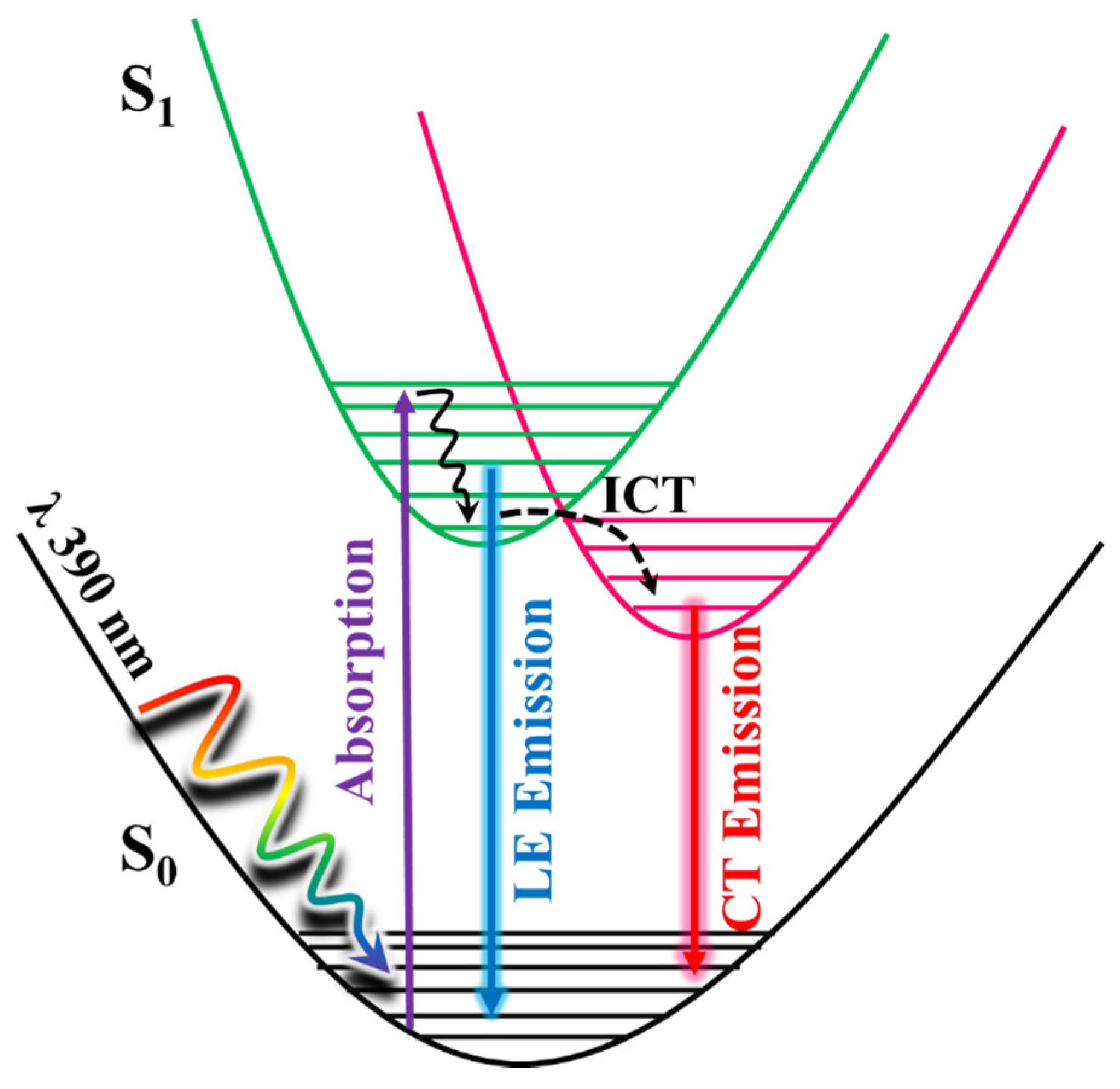
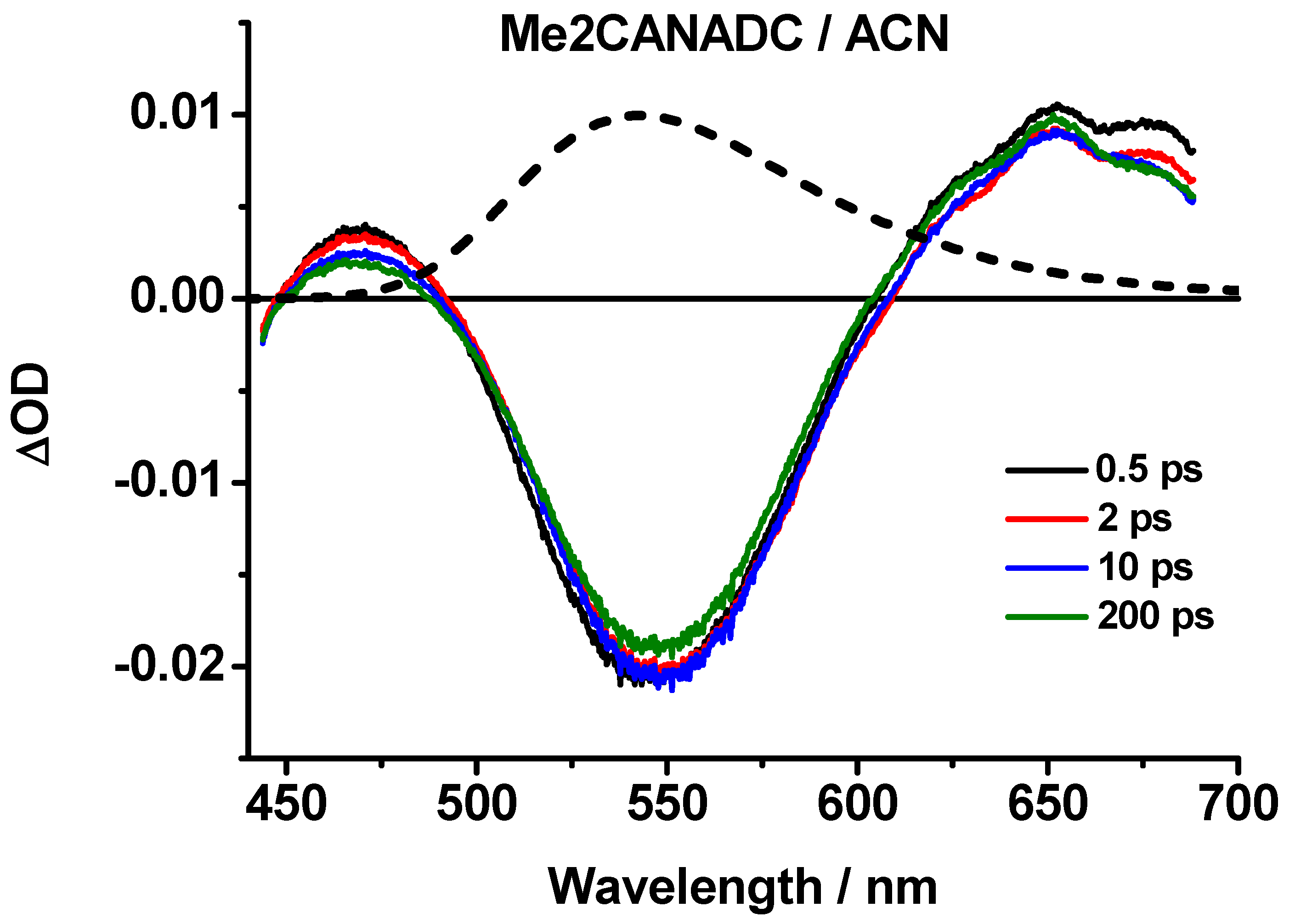
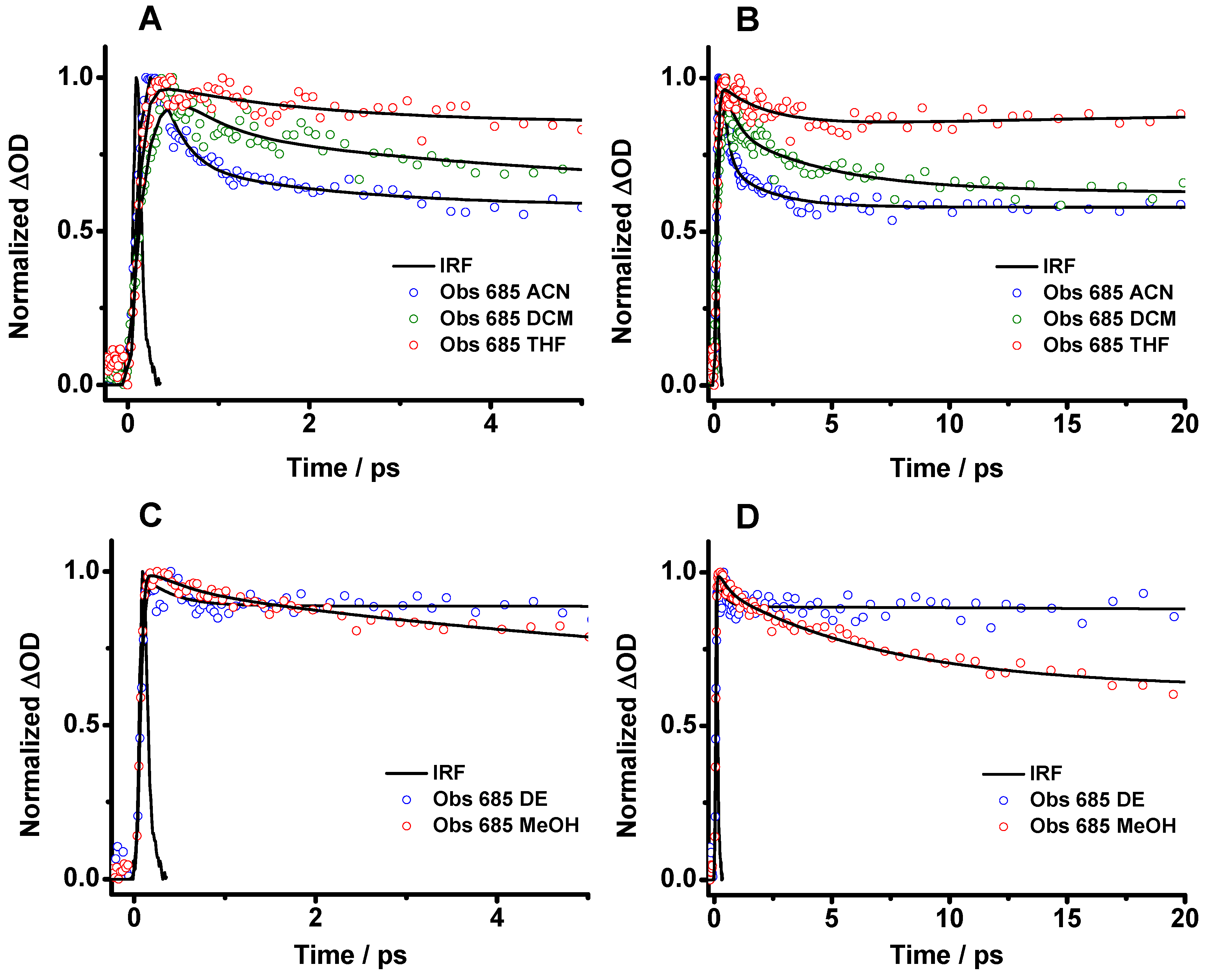
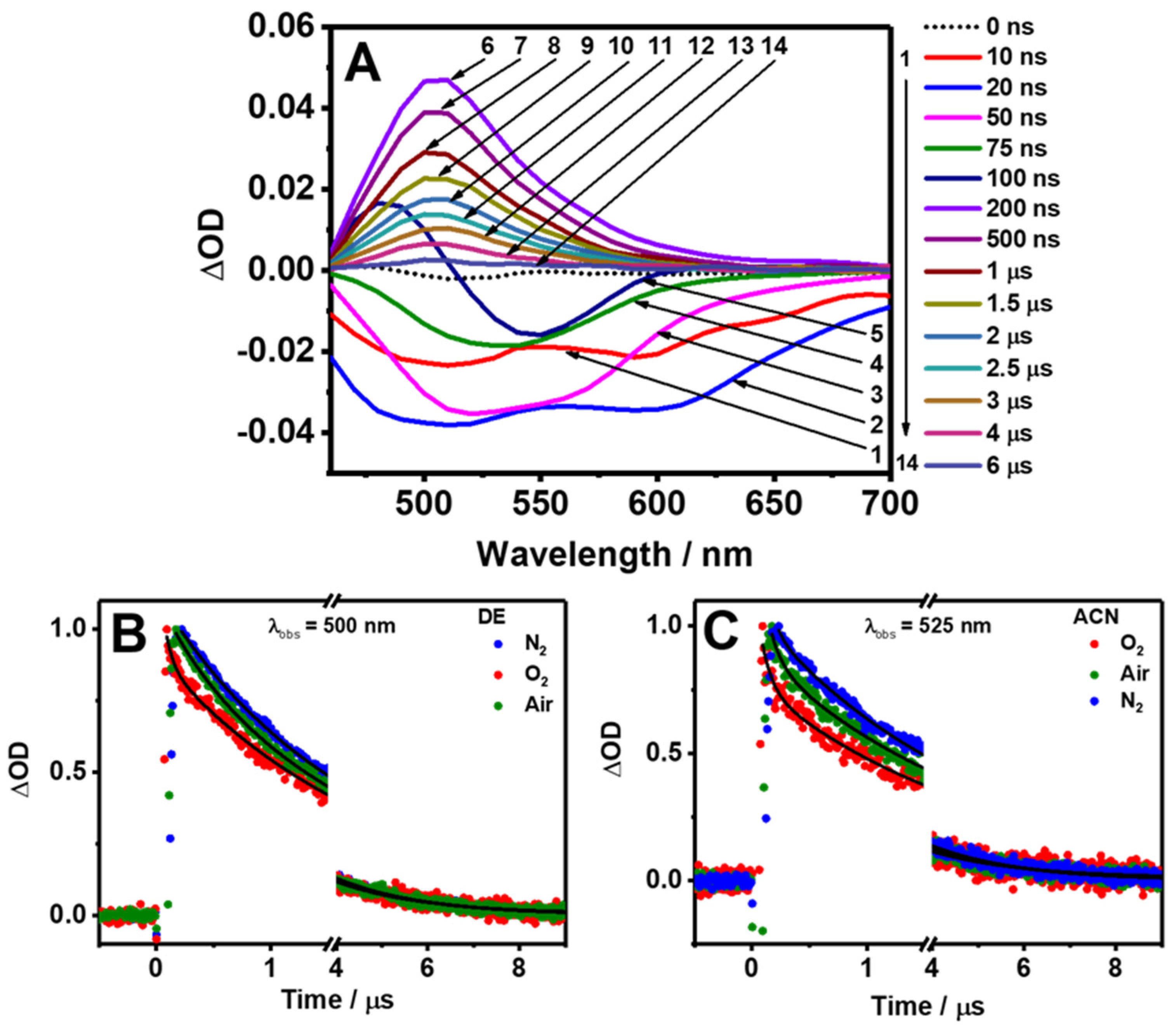
| Solvent | Number | ∆f | η (cP) | λabs (nm) | λem (nm) | Stokes Shift (cm−1) | Φ | τ (ns) | kr b (107 s−1) | knr b (107 s−1) |
|---|---|---|---|---|---|---|---|---|---|---|
| DE | 1 | 0.162 | 0.23 | 425 | 512 | 3998 | 0.40 | 17.6 | 2.27 | 3.41 |
| THF | 2 | 0.220 | 0.48 | 431 | 534 | 4475 | 0.28 | 14.7 | 1.90 | 4.90 |
| DCM | 3 | 0.230 | 0.43 | 408 | 506 | 4747 | 0.45 | 17.3 | 2.54 | 3.24 |
| ACN | 4 | 0.330 | 0.35 | 419 | 542 | 5416 | 0.16 | 14.2 | 1.06 | 5.99 |
| MeOH | 5 | 0.333 | 0.58 | 430 | 559 | 5367 | 0.10 | 8.9 | 1.12 | 10.11 |
| 1-ProOH | 6 | 0.296 | 2.22 | 436 | 557 | 4982 | 0.14 | 11.2 a | 1.25 | 7.68 |
| 1-ButOH | 7 | 0.286 | 2.90 | 436 | 557 | 4982 | 0.15 | 11.5 a | 1.30 | 7.39 |
| 1-OctOH | 8 | 0.241 | 8.46 | 436 | 553 | 4853 | 0.20 | 13.1 a | 1.53 | 6.11 |
| 1-DecOH | 9 | 0.217 | 13.19 | 437 | 551 | 4734 | 0.25 | 13.8 a | 1.81 | 5.43 |
| Solvent | λobs/nm | τ1/ps | A1 (%) | C1 (%) | τ2/ps | A2 (%) | C2 (%) | τ3/ns | A3 (%) | C3 (%) |
|---|---|---|---|---|---|---|---|---|---|---|
| 1-ProOH | 500 | 66 | 75 | 2 | - | - | - | 11.2 | 25 | 98 |
| 525 | 66 | 49 | 1 | - | - | - | 11.2 | 51 | 99 | |
| 550 | 66 | 28 | <1 | - | - | - | 11.2 | 72 | >99 | |
| 575 | 66 | 13 | <1 | - | - | - | 11.2 | 87 | >99 | |
| 600 | - | - | - | - | - | - | 11.2 | 100 | 100 | |
| 650 | - | - | - | - | - | - | 11.2 | 100 | 100 | |
| 1-ButOH | 500 | 85 | 71 | 2 | - | - | - | 11.5 | 29 | 98 |
| 525 | 85 | 52 | 1 | - | - | - | 11.5 | 48 | 99 | |
| 550 | 85 | 27 | <1 | - | - | - | 11.5 | 73 | >99 | |
| 575 | - | - | - | - | - | - | 11.5 | 100 | 100 | |
| 600 | - | - | - | - | - | - | 11.5 | 100 | 100 | |
| 650 | - | - | - | - | - | - | 11.5 | 100 | 100 | |
| 1-OctOH | 500 | 160 | 61 | 3 | 550 | 14 | 2 | 13.1 | 25 | 95 |
| 525 | 160 | 33 | 1 | 550 | 17 | 1 | 13.1 | 50 | 98 | |
| 550 | 160 | −100 | −100 | 550 | 14 | 1 | 13.1 | 86 | 99 | |
| 575 | 160 | −100 | −100 | - | - | - | 13.1 | 100 | 100 | |
| 600 | 160 | −100 | −100 | - | - | - | 13.1 | 100 | 100 | |
| 650 | 160 | −100 | −100 | - | - | - | 13.1 | 100 | 100 | |
| 1-DecOH | 500 | 280 | 60 | 4 | 955 | 12 | 3 | 13.8 | 28 | 93 |
| 525 | 280 | 31 | 1 | 955 | 15 | 2 | 13.8 | 54 | 97 | |
| 550 | 280 | −100 | −100 | 955 | 9 | 1 | 13.8 | 91 | 99 | |
| 575 | 280 | −100 | −100 | - | - | - | 13.8 | 100 | 100 | |
| 600 | 280 | −100 | −100 | - | - | - | 13.8 | 100 | 100 | |
| 650 | 280 | −100 | −100 | - | - | - | 13.8 | 100 | 100 |
| Solvent | τ1 (fs) | A1 (%) | τ2 (ps) | A2 (%) | τ3 (ps) | A3 (%) |
|---|---|---|---|---|---|---|
| DE | 50 | −100 | 0.33 | 100 | - | - |
| THF | 100 | −93 | 2.06 | 100 | 23 | −7 |
| DCM | 195 | −00 | 0.37 | 68 | 4.1 | 32 |
| ACN | 95 | −100 | 0.22 | 36 | 1.8 | 64 |
| MeOH | 70 | −100 | 0.54 | 30 | 9.5 | 70 |
| Solvent | N2 | Air | O2 | |||||||||
|---|---|---|---|---|---|---|---|---|---|---|---|---|
| τ1 (ns) | A1 (%) | τ2 (µs) | A2 (%) | τ1 (ns) | A1 (%) | τ2 (µs) | A2 (%) | τ1 (ns) | A1 (%) | τ2 (µs) | A2 (%) | |
| DE | - | - | 1.8 | 100 | 444 | 15 | 2.0 | 85 | 64 | 33 | 1.9 | 67 |
| THF | 501 | 11 | 2.0 | 89 | 236 | 18 | 2.0 | 82 | 29 | 74 | 1.9 | 26 |
| DCM | - | - | 1.8 | 100 | 564 | 12 | 1.9 | 88 | 172 | 15 | 1.9 | 85 |
| ACN | - | - | 1.9 | 100 | 104 | 42 | 2.0 | 58 | 90 | 39 | 2.0 | 61 |
| MeOH | 28 | 93 | 2.0 | 7 | 111 | 38 | 2.0 | 62 | 5 | 99 | 2.0 | 1 |
© 2020 by the authors. Licensee MDPI, Basel, Switzerland. This article is an open access article distributed under the terms and conditions of the Creative Commons Attribution (CC BY) license (http://creativecommons.org/licenses/by/4.0/).
Share and Cite
Gutiérrez, M.; Duplouy-Armani, L.; Angiolini, L.; Pintado-Sierra, M.; Sánchez, F.; Douhal, A. Femto- to Millisecond Time-Resolved Photodynamics of a Double-Functionalized Push–Pull Organic Linker: Potential Candidate for Optoelectronically Active MOFs. Int. J. Mol. Sci. 2020, 21, 4366. https://doi.org/10.3390/ijms21124366
Gutiérrez M, Duplouy-Armani L, Angiolini L, Pintado-Sierra M, Sánchez F, Douhal A. Femto- to Millisecond Time-Resolved Photodynamics of a Double-Functionalized Push–Pull Organic Linker: Potential Candidate for Optoelectronically Active MOFs. International Journal of Molecular Sciences. 2020; 21(12):4366. https://doi.org/10.3390/ijms21124366
Chicago/Turabian StyleGutiérrez, Mario, Lucie Duplouy-Armani, Lorenzo Angiolini, Mercedes Pintado-Sierra, Félix Sánchez, and Abderrazzak Douhal. 2020. "Femto- to Millisecond Time-Resolved Photodynamics of a Double-Functionalized Push–Pull Organic Linker: Potential Candidate for Optoelectronically Active MOFs" International Journal of Molecular Sciences 21, no. 12: 4366. https://doi.org/10.3390/ijms21124366
APA StyleGutiérrez, M., Duplouy-Armani, L., Angiolini, L., Pintado-Sierra, M., Sánchez, F., & Douhal, A. (2020). Femto- to Millisecond Time-Resolved Photodynamics of a Double-Functionalized Push–Pull Organic Linker: Potential Candidate for Optoelectronically Active MOFs. International Journal of Molecular Sciences, 21(12), 4366. https://doi.org/10.3390/ijms21124366






